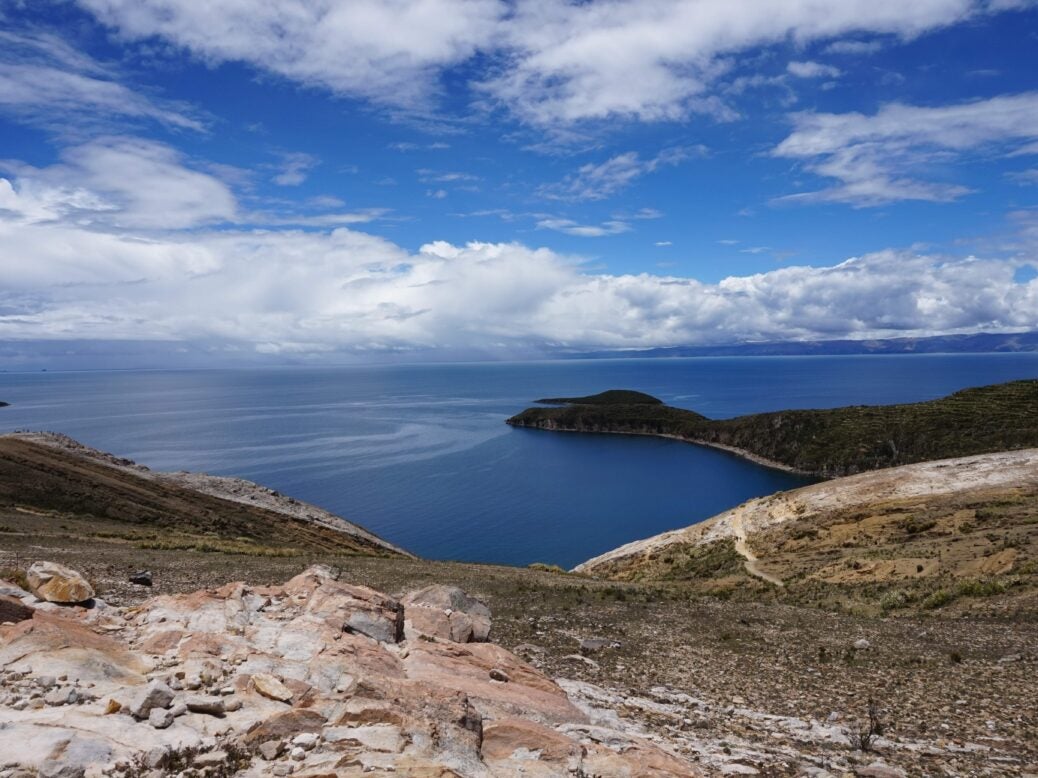
Follow the trail of the Incas with an island-hopping trip to Lake Titicaca, on the border of Bolivia and Peru, writes Hugh Thompson
Lake Titicaca one of the most talismanic destinations in the world. The great mountain lake – or should one call it a sea? – sprawls across a wide bowl of the Andes in a vast expanse of liquid turquoise.
At an altitude of a hypoxic 12,500 feet, it is the highest navigable lake on Earth and the largest by some way in South America. It needs two countries to contain its hundred mile length: shared between Peru and Bolivia, the boundary marked out on the map becomes a blurred one when in the middle of the water, as if Lake Titicaca was still part of some earlier Andean Empire – like that of the Inca or the Tiahuanaco civilisations whose ruins surround the shores.
The name Titicaca means ‘the grey puma’ in the native Aymara tongue, and seen from the surrounding peaks, many of which are well over 20,000 feet, it does look as if it is running across the mountains. It is not just a geological phenomenon – the result of an inland sea withdrawing as the Andes arose around it – but a religious one.
To visit the lake is to visit the wellspring of the Inca nation: the place from which they thought they came. The best way to arrive there is surely from Cusco, the old Inca capital; the luxury train service from Belmond (Orient Express as was) leaves the city in the late morning and spends the day climbing from Cusco’s 11,000 feet to the heights of the La Raya pass at 15,000 feet.
It harks back to a distant age of luxury train travel, sipping pisco sours in the open observatory car as we travelled through what is still a very rural part of Peru. In August, when I took the train, alpaca were grazing in the fields and the maize stubble was being burnt after the harvest.
Teams of women with pigtails descending from below their bowler hats patrolled the ploughed fields looking for clods of earth that needed breaking up before the next maize crop could be sown. With some anticipation, we made ourselves ready for the three course lunch, curated by chef Diego Muñoz – formerly of Spanish restaurant El Bulli, which has regularly topped the global gastronomic charts. A playful variant on the old Andean staple of choclo con queso, corn and cheese, as a starter was followed by sea bass baked using exotic local herbs like huacatay.
The train climbed even higher, curving around the sacred river of the Vilcanota as tea was served in the luxurious wagon cars: maté de coca for those concerned about the altitude, more pisco sours for those who weren’t. This is the only train I’ve ever been in with a full grand piano in the bar. We reached the highest point at dusk, with an obligatory stop by the tiny chapel on the pass to buy alpaca jerseys from the old Indian ladies, before retiring to our sleeping cabins.
Waking at dawn, we found ourselves at Lake Titicaca; a spectacular sight. The quality of light over the vast expanse of high altitude water is fascinating, with the low clouds passing through the stratosphere making for a wonderful sunrise. Passengers line the quayside to watch, helped by strong cappuccinos, as the long, lean islands on the lake were silhouetted against the rising sun like emerging black submarines.
Later, we motored out to the famous ‘floating islands’ made from totora reed, anchored by eucalyptus poles to the bottom of the lake. They are home to the Uros Indians, who created them in pre-Columbian times to escape Inca domination. Fiercely independent, the 2,000 or so Uros tribespeople eke out an existence from fishing and tourism. Nearby are the more solid islands of Amantani and Taquile, where even the smallest scrap of agricultural land is used to grow maize, which flourishes in the island micro-climate.
The Quechua Indians here are also obsessed with weaving. Men and women walk around the island spinning thread as they go, their bright red costumes using the cochineal beetle to startling effect.
On the island of Amantani, you’ll also find the Amantica Lodge hotel – a single house projecting over the water, with huge plate windows bringing the outside into this intimate hideaway. The largest of all the islands lies on the Bolivian side of the lake: la Isla del Sol, or ‘the Island of the Sun’ – a place of mesmeric importance for the Incas, who saw it as the place their race had originated, and hence made pilgrimages here.
The pilgrims would approach along the peninsula that extends into the lake from the south, helping divide modern-day Peru from Bolivia, before setting sail in small reed boats to the island, landing at what are now the soft honey-coloured ruins of Pilko Kayma – an intimate warren of rooms, some with fine corbelled roofs, a rarity in pre-Columbian Peru.
Pilgrims would then trek five miles north to the Sacred Rock (which the sun was believed to have emerged from), via the natural harbour of Yumani. At Yumani, they climbed an imposing Inca stairway, which still has a fountain at the top for ritual purification. Accommodation at Yumani is far simpler than the luxurious offerings of the Belmond train or Amantica hotel.
There are no infusions of Andean mint drizzled over black quinoa here, as tourism is still in its infancy – but the solar-powered La Estancia eco-lodge is an attractive and simple place to stay, looking out over the smaller Island of the Moon, which lies to the east with its own set of Inca ruins.
From Yumani, follow the high path the Incas took, along a ridge that runs the length of the island. The walk is an uplifting one, with a wonderful sense of following an ancient tradition that may have even begun with the earlier Tiahuanaco civilisation, from which the Incas borrowed so much.
Looking down from the pilgrimage route, the lake looks as if it has been brushed with one of the cactus spine combs that the pre-Columbians used, so fine are the lines radiating out from all of the smaller islands. Although the path runs less than a thousand feet above the lake, the perspective down to the water’s edge gives the illusion that one is striding off the end of the world.
At the tip of the island is the Sacred Rock, from which the Adam and Eve of Inca myth – Manco Capac and his sister Mama Occlo – were believed to have emerged. Around this, the Incas built the Chincana, a complex that was ‘as labyrinthine as Crete’ according to the 17th century chronicler Bernabe Cobo.
The name ‘Chincana’ means ‘the place where one gets lost’ and, though ruined, it remains an intriguing maze of buildings, configured around closed plazas, with a magnificent setting, looking out across the sweep of a turquoise-fringed bay. In the distance, small twisters were forming on the lake and spinning like tops across its surface.
As I gazed across the water, before taking a ferry back to the mainland, I reflected on how this inland sea of Titicaca remains a place deeply imbued with the spirit of the Andes and the sacred rituals of its earliest civilisations. A rare place of pilgrimage indeed.
Aracari offers a 10-day Lake Titicana trip from $5,508 per person (based on two sharing), inc. accomodation at Inkaterra La Casona in Cusco, overnight trip on the Belmond Andean Explorer, and stays at Libertador Lake Titicaca, La Estancia and Amantica. Price includes excursions, transfers and domestic flights. International flights from London to Lima start from £600 return. aracari.com
This article first appeared in the Spear’s magazine Travel Guide
Photography: Danielle Miller













